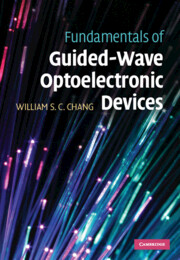3 - Electro-optical effects
Published online by Cambridge University Press: 25 January 2011
Summary
Electro-optical effects in materials are used to switch, modulate, detect, amplify, or generate optical radiation in guided-wave devices.
The best known electro-optical effect is probably the amplification of optical radiation by stimulated emission of radiation. In edge-emitting semiconductor lasers, the amplification of the guided wave is obtained via current injection in a forward biased p–n junction. In a laser oscillator, the waveguide is terminated by reflectors (or coupled to a feedback grating) to form a resonant cavity. When amplification exceeds losses in the cavity, oscillation is obtained. When end reflections (or feedback) are absent and when there is net gain, a laser amplifier is obtained. The second well known electro-optical effect is detection of optical radiation by photo-generation of carriers. For optical radiation incident on a semiconductor with photon energy greater than the semiconductor bandgap, electrical carriers are generated by the absorption of incident radiation. In a semiconductor detector, photo-generated carriers in a reverse biased p–i–n junction are collected and transmitted to the external circuit. In waveguide photo-detectors, the optical radiation is incident on to and absorbed in a waveguide so that the absorption can be distributed over a distance, enabling the detector to absorb more effectively the incident optical power over a longer distance while maintaining a large operation bandwidth. Discussion of carrier injection, stimulated emission and carrier transport in semiconductor junctions requires extensive review of semiconductor device physics. There are already many books on lasers and detectors.
- Type
- Chapter
- Information
- Fundamentals of Guided-Wave Optoelectronic Devices , pp. 69 - 96Publisher: Cambridge University PressPrint publication year: 2009



